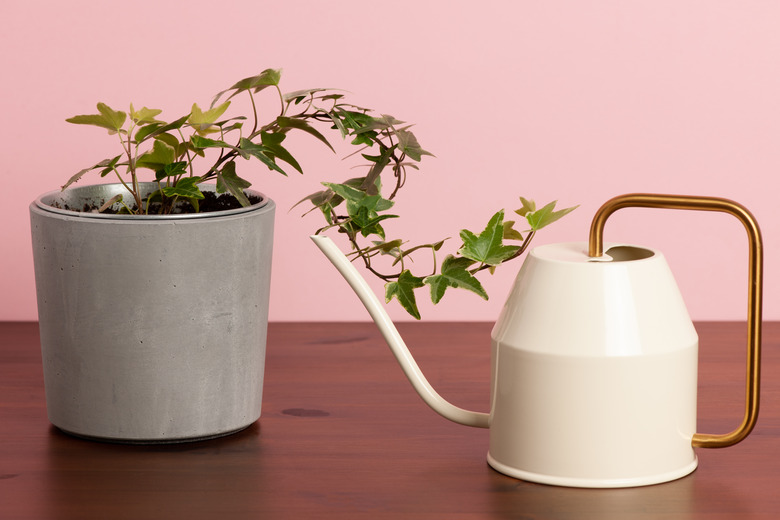How Often Do You Water English Ivy As An Indoor Plant?
We may receive a commission on purchases made from links.
The English ivy (Hedera helix, USDA zones 4-11) will be a welcome addition to your home if you'd like a low-maintenance plant that is attractive in appearance. Once you have found the right location for your indoor ivy, it will grow effortlessly with good light and water. This ivy is a climber and given the right location is seemingly unstoppable. Ivy is also well suited for trailing across a mantel or cascading from a hanging basket.
Tip
English ivy needs regular watering. The best way to tell if this plant needs moisture is to test the soil with your finger to see if it's dry.
English Ivy Water Needs
English Ivy Water Needs
Check the soil for moisture content before adding more water. Use your finger to test the top inch of soil; if the top inch is dry, the ivy is in need of water. Add water by pouring it onto the soil until the excess drains from the container. Use water that is lukewarm or water that is at least room temperature.
Misting the plant daily will also help discourage invasion by spider mites, an enemy of English ivy. The ivy prefers a room temperature of 50 to 70 degrees Fahrenheit; warmer room temperatures may require more frequent watering to keep the soil moist, but do not let the soil become soggy.
English Ivy and Light
English Ivy and Light
Place the plant where it will receive bright, but not direct sunlight. The ivy also grows well under fluorescent lighting. If you have a plant with variegated leaves that start to change color to mostly green, this may be an indication that the plant isn't getting enough light. You will need to provide more sun for the ivy leaves to remain variegated, and also remove stems with mostly green leaves. Leaves will grow toward the sun, and the pot needs to be rotated occasionally to prevent a lop-sided look.
Fertilizing English Ivy
Fertilizing English Ivy
Fertilize English ivy once a month starting in the spring and into fall while the plant is in an active growth period. Use a liquid fertilizer that has a high-nitrogen content. The fertilizer container will be labeled as high-nitrogen. When temperatures are more extreme (either cool or hot), suspend fertilization for that period of time as plant growth will slow or stop.
Soil for English Ivy
Soil for English Ivy
General, all-purpose potting soil works well for English ivy. The soil should retain water and also drain well. Homemade potting mix can also be made from equal parts of humusy garden soil, coarse sand, moist peat and a small amount of lime. Partially fill the pot with soil and add the ivy. Fill the area around the plant with more soil and lightly compact the soil. The soil will compact itself more after the first watering, and you may need to add more soil.
Cautions for English Ivy
Cautions for English Ivy
English ivy can be prone to drying out. For this reason, avoid setting the ivy in a draft, and keep it away from heating vents which will cause dry leaves. It's also important to note that the leaves of this plant are toxic if eaten and can cause skin irritation. Because of this you should wear gardening gloves when pruning or potting to help protect your skin.
